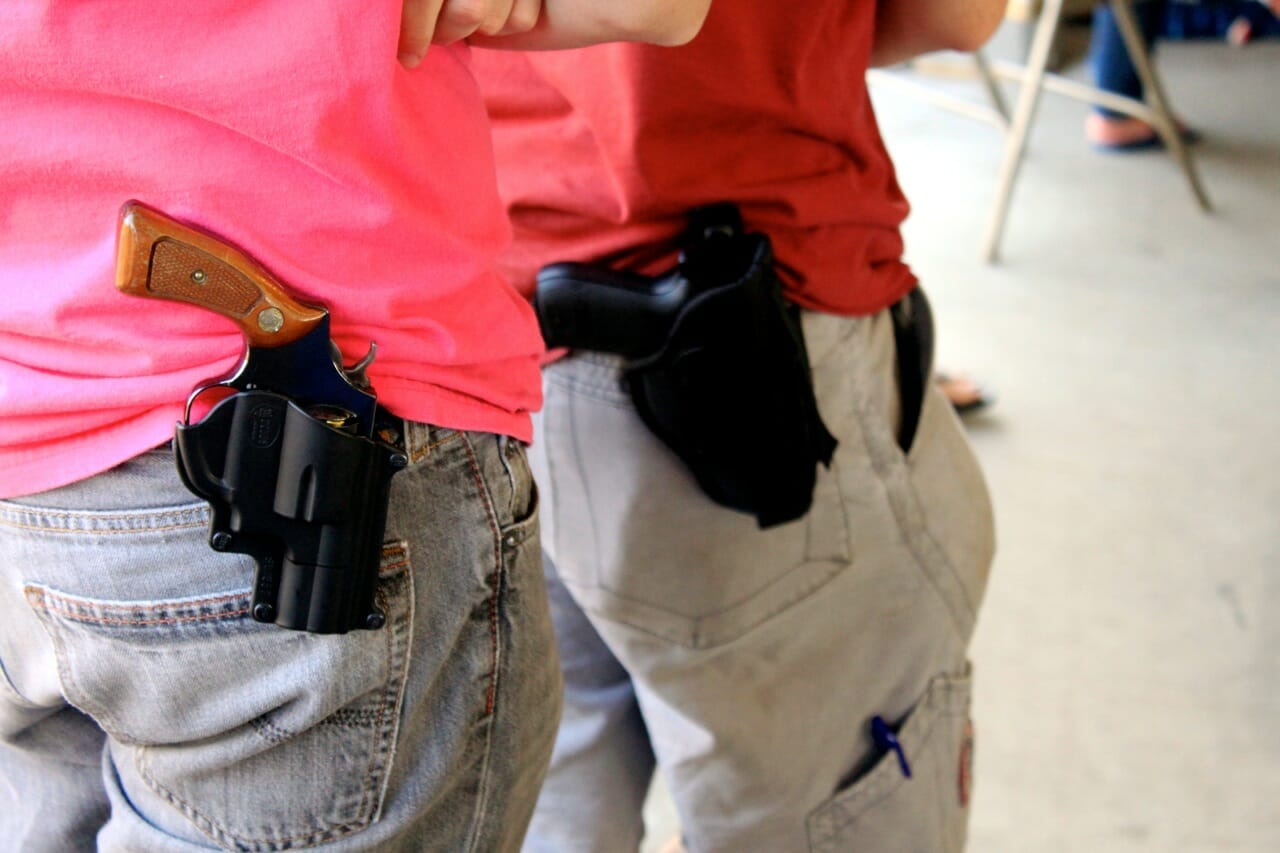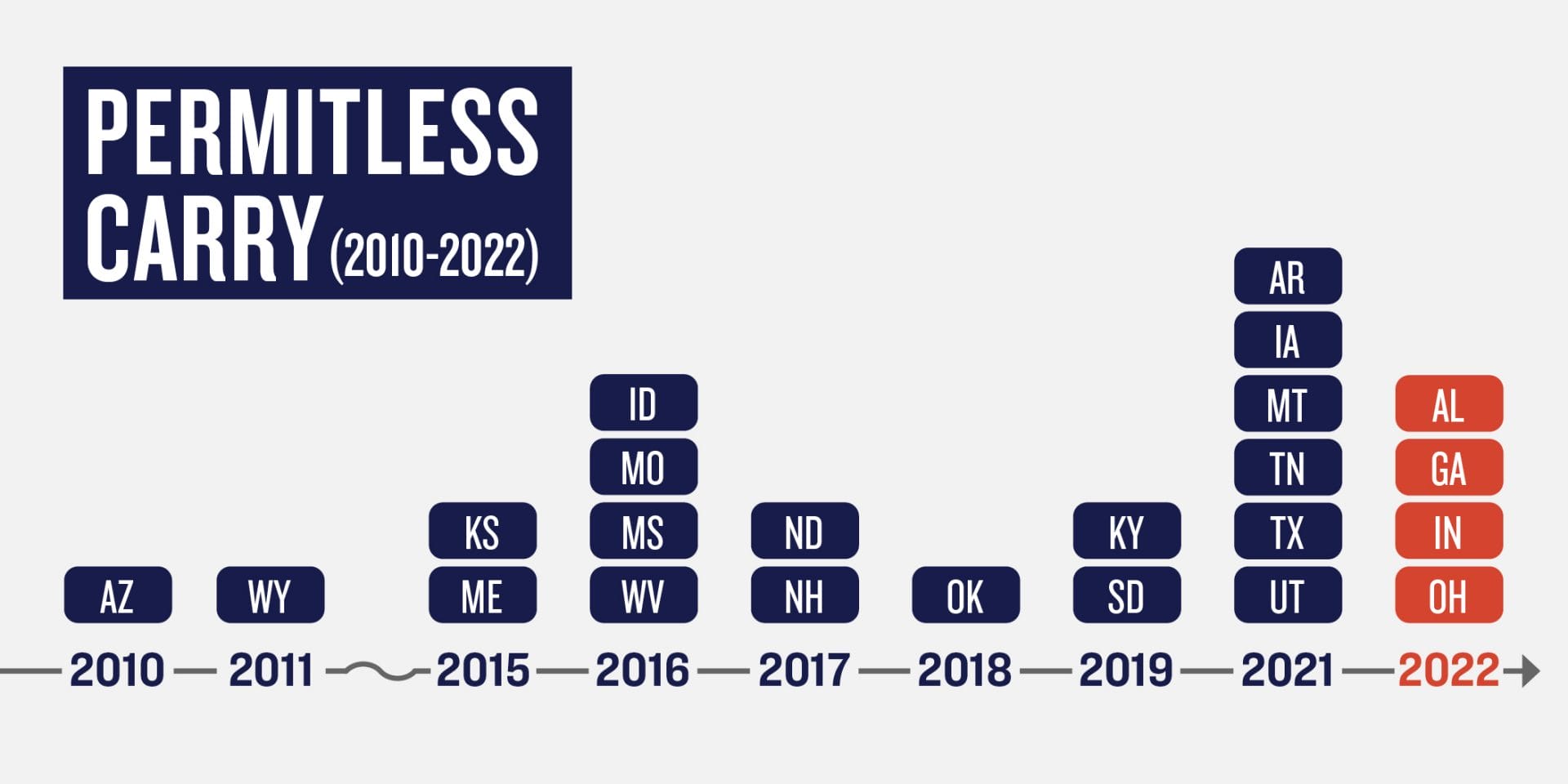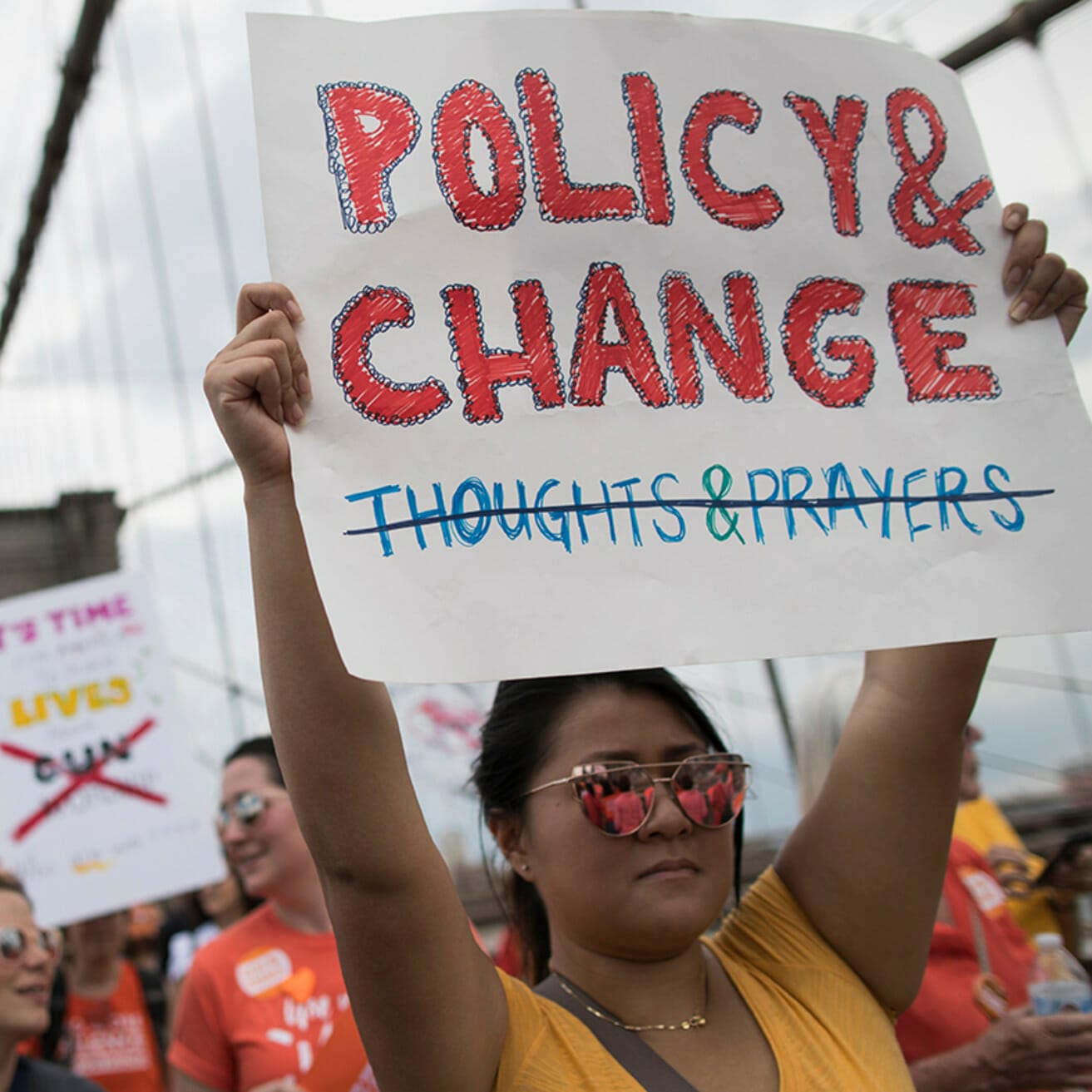
The Truth About Permitless Carry
Months after Texas enacted a permitless carry law, a father of three was shot to death in an argument about a parking spot.1 Less than a year after Tennessee enacted a permitless carry law, a manager shot at a customer who complained about the wait time at a restaurant.2 Just days after Georgia enacted permitless carry, an 18-year-old shot a man in a supermarket over a dispute in the meat department.3
Factsheet: Why Permitless Carry Is Bad for Florida

As demonstrated in the examples above, guns carried in public create the opportunity for everyday arguments to escalate into violent conflicts. Alarmingly, however, many states have weakened or eliminated public carry requirements in recent years. In fact, in just the last seven years, 21 states have adopted permitless carry laws which allow people who have never passed a background check or fired a gun in their lives to carry hidden, loaded guns in public crowds as soon as they buy them. As of December 2022, 25 states are permitless carry states, and more states have vowed to enact this policy.4
Proponents of this policy have dubbed it “constitutional carry” but there is nothing in the Constitution requiring unvetted, potentially dangerous, and untrained people be allowed to carry a gun in public. In fact, research is abundantly clear that more guns in public spaces make us less safe, not more. Yet the gun lobby continues to pressure policymakers to eliminate this fundamental standard—putting public safety in jeopardy.
MEDIA REQUESTS
Our experts can speak to the full spectrum of gun violence prevention issues. Have a question? Email us at media@giffords.org.
Contact
States with public carry permitting systems generally include important public safety standards for those who wish to carry hidden guns around public streets, buildings, restaurants, parks, and businesses. For example, states which require a public carry permit often require individuals who wish to carry guns in public to undergo a background check and take a firearm safety course. Many states also have higher eligibility standards for public carry than for firearm purchasing or possession, making some people who can legally possess a gun in their homes ineligible to carry that weapon in public based on their criminal history. Permitless carry laws strip these important protections.
Background Checks
Background checks are a foundational policy critical to keeping firearms out of the hands of individuals at an elevated risk of committing violence. When required to obtain a concealed carry permit, background checks can help ensure that people with a history of violent or risky behavior cannot carry firearms in public places. In fact, data suggests that thousands of people with disqualifying histories are denied concealed carry permits each year. For instance, between July 1, 2021, and June 30, 2022, 7,605 Florida residents with a disqualifying history were denied concealed carry permits.5
Perhaps even more alarmingly, in many cases, when states adopt permitless carry laws, people can buy and carry loaded weapons in public without ever passing a background check or firing a gun. In fact, only one of the 25 permitless carry states requires a person to pass a background check to buy a gun.

Eligibility Standards
States that require people to obtain a permit to carry concealed weapons can—and in many cases do—set higher eligibility standards for carrying concealed weapons in public. For example, some states prohibit people with a history of violent misdemeanors from carrying concealed firearms, even if people convicted of these offenses are still eligible to purchase and possess firearms. Permitless carry systems eliminate these higher standards. In fact, six of the 10 states that passed permitless carry laws in 2021 and 2022 stripped violent misdemeanor prohibitions, allowing individuals with a history of violence to legally carry firearms in public.
Law enforcement officials have noted how removing these protections constrains their ability to protect public safety. For example, the Sheriff of Hamilton County, Ohio, lamented that the state’s recently enacted permitless carry law limits her oversight over who can carry a concealed weapon. She notes that “Prior to this bill being passed, [she] rescinded last year some 200 concealed carry permits from those charged with crimes such as domestic violence or assault. Now, [she] can’t do that, and those 200 people can conceal carry without the benefit of law enforcement oversight.”6
Research is abundantly clear that keeping firearms away from those convicted of violent misdemeanors promotes public safety. People who are allowed to legally purchase handguns after committing a violent misdemeanor subsequently commit violent and firearm-related crimes at seven times the rate of handgun purchasers without such convictions.7 Laws that prohibit people convicted of violent misdemeanors from acquiring firearms are associated with lower rates of violent and firearm-related crime.8
A recent study confirms that this heightened eligibility standard for concealed carry permits also increases public safety: states which weakened permitting laws and allowed people convicted of violent misdemeanors to obtain permits experienced a 24% increase in firearm assaults.9
Firearm Safety Training
Concealed carry permitting systems typically require people to undergo firearm safety training to carry firearms in public. States that adopt permitless carry laws allow people to carry guns in public without ever taking a firearm safety training. Anecdotal evidence suggests that the removal of the legal requirement to complete a safety training course leads to decreases in enrollment in these classes.10
Source
Michael Siegel, et al., “Easiness of Legal Access to Concealed Firearm Permits and Homicide Rates in the United States,” American Journal of Public Health 107, no. 12 (2017): 1923–1929.
States regularly require training in a number of different fields as a means to promote public health and safety. For instance, on average, states require 1,551 hours of training to obtain a license to cut hair, 500 hours of training to obtain a massage therapist license, and 377 hours of training to become a licensed manicurist.11 The 25 states with permitless carry laws require zero hours of training—or even require that a person has ever held a gun—to carry a loaded firearm in public.
Firearm safety training is critical to promoting responsible firearm carrying and ownership. Often these trainings teach gun owners about safe storage, responsible handling of firearms, and basic marksmanship. Studies suggest that these trainings have measurable benefits: one experiment found that people with lower levels of firearm training performed worse than those with higher levels of training in a self-defense simulation.12 In fact, many people with low levels of training unintentionally “shot” innocent bystanders or unarmed people in the simulation.13
Recent research also confirms that removing the live fire training requirement leads to increases in gun violence: states which weakened permitting laws and allowed people to obtain permits with no live fire training experienced an 18% increase in firearm assaults.9
In addition to the broad public safety benefits of firearm safety training, these requirements also provide benefits to the gun carrier. Even in permitless carry states, state and federal laws restrict the carrying of guns in some sensitive areas such as schools, hospitals, and government properties. Firearm safety courses provide education about the laws which regulate firearm carrying both within state and across state lines, helping reduce the chance that people who carry guns may inadvertently violate the law and expose themselves to consequences.
Given that permitless carry laws strip these important protections, it is unsurprising that research overwhelmingly shows that gun violence and other violent crime increase when states weaken their public carry standards. Studies show that weakening public carry laws is associated with a 13–15% increase in violent crime rates,14 as well as an 11% increase in rates of homicides committed with handguns.15 A study looking specifically at cities found that violent firearm crime increased 29% in cities within states that weakened firearm permitting laws, with the largest increases shown in firearm robberies.16
Other studies have similarly found that weaker concealed carry laws increase other forms of violence as well. One analysis found that states with weak or no regulations on concealed carry had 29% higher rates of workplace homicides committed with firearms.17 Another found that states which enacted permitless carry experienced a 13% increase in fatal and nonfatal police shootings of civilians compared to what would have been expected had stronger carrying standards remained in place.18
Critically, recent research suggests that these increases in violent crime will occur simply from adopting weaker concealed carry standards—regardless of whether or not the majority of people who carry are so-called law-abiding. Weak public carry laws require police to deal with the abundant challenges of a more armed public, which may reduce their time, safety, and effectiveness in investigating and solving crime.19
Numerous law enforcement agencies and officials have shared these challenges, with the Tennessee Bureau of Investigation senior policy adviser Jimmy Musice noting that requiring permits for concealed carry makes it easier for officers to determine if a “person truly is lawful”20 and the Dallas Police Association President Michael Mata sharing that permitless carry means police “have no idea who the good guy is…nobody wears a t-shirt that says ‘I’m the good guy.’”21 These challenges translate into measurable decreases in police effectiveness: researchers documented a 13% decline in police clearance rates for violent crimes in cities within states that weakened concealed carry laws.16
Additionally, lax concealed carry laws among this same sample of cities were shown to lead to a 35% increase in gun thefts,13 which research shows can be an important source of crime guns.22 A smaller study of one North Carolina county found that weak concealed carry laws lead to an increase in gun thefts that lead to violent crime increases.23
Permitless carry laws not only increase the risk of intentional violence, but also the risk of unintentional shootings, with some extant research suggesting that unintentional firearm injuries may occur more frequently after states weaken permitting standards.24 Recent examples make it easy to understand what may underlie these increases. In one instance, a couple was buying ice cream in a Texas parking lot when one of them was struck by a stray bullet from a dispute 50 yards away.25 This incident happened less than seven months after permitless carry went into effect in Texas. Roughly 18 months after permitless carry went into effect in Iowa, a woman unintentionally shot herself outside a Walmart while with her husband and three children.26
The risks of permitless carry laws are clear, and there is no credible statistical evidence that these laws produce widespread public safety benefits. Put simply, claims that permissive concealed carry laws lead to decreases in crime—by sending the message to would-be attackers that any potential victim might be packing heat—are simply untrue. What is abundantly clear, however, is that these permissive laws increase the likelihood of gun deaths and injuries.
There is no doubt about it: our nation is in the midst of a gun violence crisis. A record number of Americans lost their lives due to gun violence in 2021, and more than 110 people die from this preventable epidemic every day.27
But permitless carry laws are not the water hose to put out this fire—they are gasoline to the flames. Having unvetted, untrained people carrying hidden loaded guns in our malls, supermarkets, movie theaters, restaurants, and city streets will undoubtedly make those places less safe, turning arguments and fistfights into deadly shootings. Policymakers that want to save lives from gun violence and promote public safety must look to the policies that are actually proven to work—such as universal background checks, extreme risk laws, and safe storage laws—not policies designed by the gun lobby to flood our streets with more guns.

SPOTLIGHT
GUN VIOLENCE STATISTICS
Explore facts, figures, and original analysis compiled by our experts. To end our gun violence crisis, we need to better understand where, how, and why violence occurs.
Learn More- Andrew Stanton, “Man Killed in Walmart Lot Over ‘Driving and Parking’: Police,” Newsweek, August 30, 2022, https://www.newsweek.com/houston-texas-walmart-parking-lot-shooting-death-1738173.[↩]
- Adam Staten, “Restaurant Manager Shoots at Customer After Argument Over Wait Time: Police,” Newsweek, June 23, 2022, https://www.newsweek.com/restaurant-manager-shoots-customer-after-arguement-over-wait-time-police-tennessee-1718665.[↩]
- Tanasia Kenney, “18-year-old Shoots Man During Argument in Walmart Meat Department, Georgia Police Say,” The Telegraph, July 8, 2022, https://www.macon.com/news/state/georgia/article263289608.html.[↩]
- See, e.g., “DeSantis Expects Florida to Pass Permitless Carry Gun Law in 2023,” Tampa Bay Times, December 16, 2022, https://www.tampabay.com/news/florida-politics/2022/12/16/permitless-carry-constitutional-carry-gun-law-desantis-renner/; Matt Chibe and Jessica Blum, “Nebraska Senator Thinks Permitless Concealed Carry Will Pass this Legislative Session,” KLKN News, December 12, 2022, https://www.klkntv.com/nebraska-senator-confident-his-divisive-gun-rights-bill-will-pass-this-legislative-session/.[↩]
- “Concealed Weapon or Firearm License Reports: Applications and Dispositions by County,” Florida Department of Agriculture and Consumer Services, Division of Licensing, last accessed January 18, 2023, https://www.fdacs.gov/content/download/98643/file/07012021_06302022_cw_annual.pdf.[↩]
- Charmaine McGuffey, “Charmaine McGuffey: Bring Back Concealed Carry License Requirements,” CNN, October 13, 2022, https://www.cnn.com/2022/10/12/opinions/gun-violence-crime-solutions-roundup/index.html.[↩]
- Garen J. Wintemute et al., “Prior Misdemeanor Convictions as a Risk Factor for Later Violent and Firearm-related Criminal Activity Among Authorized Purchasers of Handguns,” JAMA 280, no. 24 (1998): 2083–2087.[↩]
- Garen J. Wintemute et al., “Subsequent Criminal Activity Among Violent Misdemeanants Who Seek to Purchase Handguns: Risk Factors and Effectiveness of Denying Handgun Purchase,” JAMA 285, no. 8 (2001): 1019–1026.[↩]
- Mitchell L. Doucette et al., “Impact of Changes to Concealed-Carry Weapons Laws on Fatal and Nonfatal Violent Crime, 1980–2019,” American Journal of Epidemiology (2022).[↩][↩]
- Paige Thompson et al., “What Happens When States Adopt Permitless Carry Laws?,” The Urban Institute, September 4, 2019, https://www.urban.org/urban-wire/what-happens-when-states-adopt-permitless-carry-laws.[↩]
- “The National Occupational Licensing Database,” National Conference of State Legislatures, updated August 12, 2022, https://www.ncsl.org/labor-and-employment/the-national-occupational-licensing-database.[↩]
- Joseph J. Vince, Jr., Timothy Wolfe, and Layton Field, “Firearms Training & Self-Defense: Does the Quality and Frequency of Training Determine the Realistic Use of Firearms by Citizens for Self-Defense?,” Mount St. Mary’s University and the National Gun Victims Action Council, 2015, https://www.multivu.com/players/English/65360-ngvac-national-gun-victims-tell-and-compel-we-re-done-asking/flexSwf/impAsset/document/c6b7ad45-3bc2-4483-9de1-4dc5dc9d449f.pdf.[↩]
- Id.[↩][↩]
- John H. Donohue, Abhay Aneja, and Kyle D. Weber, “Right-to-carry Laws and Violent Crime: A Comprehensive Assessment Using Panel Data and a State-level Synthetic Control Analysis,” Journal of Empirical Legal Studies 16, no. 2 (2019): 198–247.[↩]
- Michael Siegel et al., “Easiness of Legal Access to Concealed Firearm Permits and Homicide Rates in the United States,” American Journal of Public Health 107, no. 12 (2017): 1923–1929.[↩]
- John J. Donohue et al., “More Guns, More Unintended Consequences: the Effects of Right-to-carry on Criminal Behavior and Policing in US Cities,” National Bureau of Economic Research, no. w30190 (2022).[↩][↩]
- Mitchell L. Doucette, Cassandra K. Crifasi, and Shannon Frattaroli, “Right-to-carry Laws and Firearm Workplace Homicides: a Longitudinal Analysis (1992–2017),” American Journal of Public Health 109, no. 12 (2019): 1747–1753.[↩]
- Mitchell L. Doucette et al., “Officer-Involved Shootings and Concealed Carry Weapons Permitting Laws: Analysis of Gun Violence Archive Data, 2014–2020,” Journal of Urban Health (2022): 1–12.[↩]
- John J. Donohue et al., “More Guns, More Unintended Consequences: the Effects of Right-to-carry on Criminal Behavior and Policing in US Cities,” National Bureau of Economic Research, no. w30190 (2022); John H. Donohue, Abhay Aneja, and Kyle D. Weber, “Right-to-carry Laws and Violent Crime: A Comprehensive Assessment Using Panel Data and a State-level Synthetic Control Analysis,” Journal of Empirical Legal Studies 16, no. 2 (2019): 198–247.[↩]
- Kimberlee Kruesi, “Tennessee GOP Pushes Gun Bill Over Law Enforcement Concerns,” Associated Press, April 1, 2021, https://apnews.com/article/joe-biden-violence-legislation-racial-injustice-tennessee-74925fdeb101c8e78cc311e6fd85b7f2.[↩]
- Michael McCardel, “‘0 Training and 0 Background Checks; That’s a Recipe for Disaster’: Law Enforcement Braces for Permitless Carry in Texas,” WFAA News, June 8, 2021, https://www.wfaa.com/article/news/politics/law-enforcement-experts-concerns-texas-permitless-carry-law/287-785cc73b-c95d-4b8b-9c97-768c39647862.[↩]
- See, e.g., Anthony Fabio et al., “Gaps Continue in Firearm Surveillance: Evidence from a Large US city Bureau of Police,” Social Medicine 10, no. 1 (2016): 13–21; Brian Freskos, “Missing Pieces: Gun Theft from Legal Gun Owners is on the Rise, Quietly Fueling Violent Crime,” The Trace, November 20, 2017, https://bit.ly/2izST1h.[↩]
- Stephen B. Billings, “Smoking Gun? Linking Gun Ownership to Neighborhood Crime,” SSRN Working Paper (2020).[↩]
- Jeffrey DeSimone, Sara Markowitz, and Jing Xu, “Child Access Prevention Laws and Nonfatal Gun Injuries,” Southern Economic Journal 80, no. 1 (2013): 5–25. See also, “Effects of Concealed-Carry Laws on Unintentional Injuries and Deaths,” RAND, Gun Policy in America, https://www.rand.org/research/gun-policy/analysis/concealed-carry/unintentional-injuries.html.[↩]
- “Innocent Bystander Shot in Texarkana While Caught Between Dispute,” KTBS News, March 25, 2022, https://www.ktbs.com/news/texarkana/innocent-bystander-shot-in-texarkana-while-caught-between-dispute/article_8623bc60-ac9e-11ec-86eb-675660f68c33.html.[↩]
- “Woman Critically Injured After Accidental Shooting in Walmart Parking Lot,” KWWL News, December 3, 2022, https://www.kwwl.com/news/top-stories/woman-critically-injured-after-accidental-shooting-in-walmart-parking-lot/article_f9bb4a6e-7357-11ed-860b-13a2615b3e2a.html.[↩]
- Centers for Disease Control and Prevention, Wide-ranging Online Data for Epidemiologic Research (WONDER), “Underlying Cause of Death, 2018–2021, Single Race” last accessed January 11, 2023, https://wonder.cdc.gov/.[↩]
